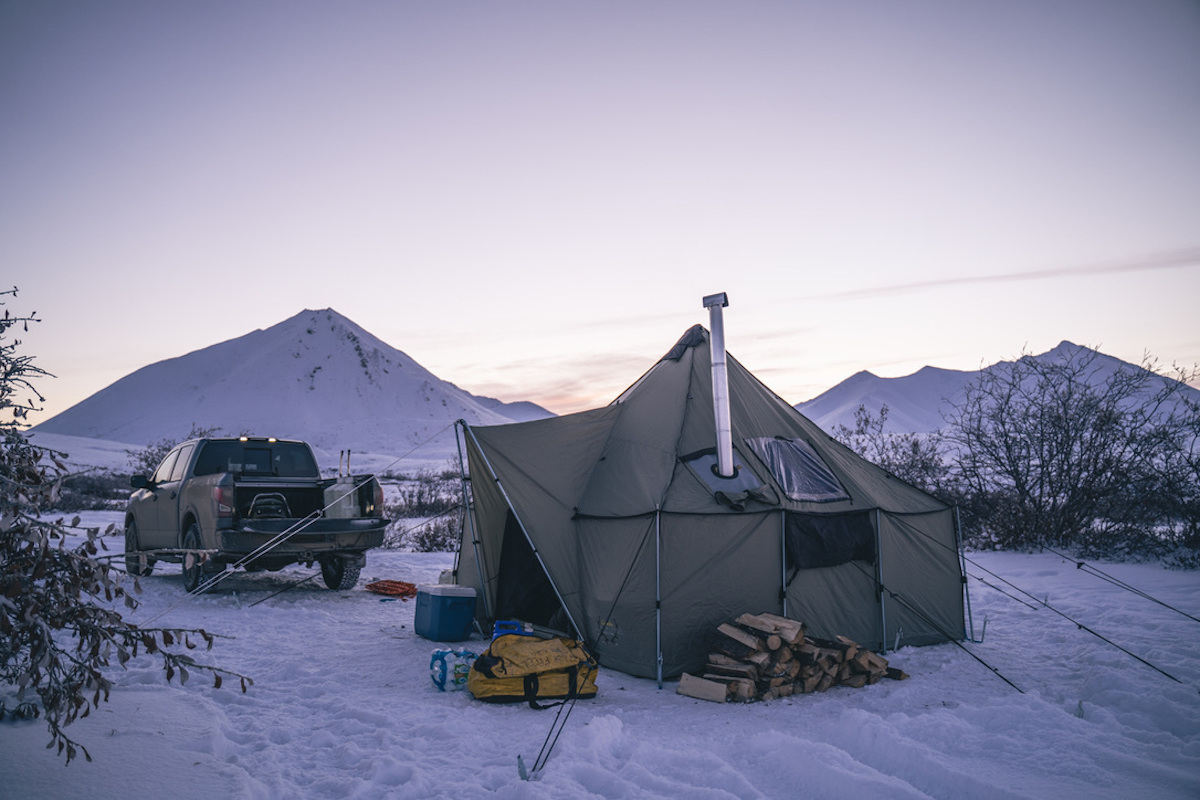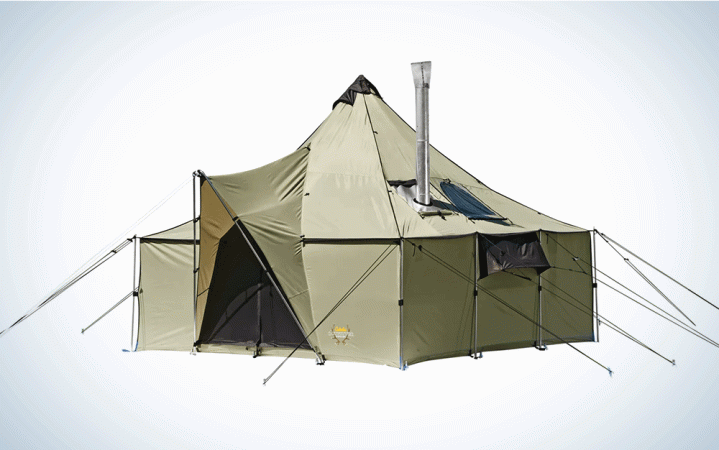We may earn revenue from the products available on this page and participate in affiliate programs. Learn More ›
In many ways, the success of a hunting trip can revolve around the tent or shelter you use. This isn’t always the case of course, but a shelter that keeps you comfortable, warm, and dry can help you to be better rested, better prepared, and make a huge difference in maintaining positive morale on difficult hunts. A tent like Cabela’s Ultimate Alaknak Outfitter Tent excels at keeping hunters warm and comfortable.
That’s why I chose it for an early October caribou hunt on Alaska’s North Slope. By the beginning of October, winter is rapidly beginning to set in that far into the Arctic, and I needed a tent that could hold up to high winds and accommodate a wood stove. At right around $700, the 10-foot Alaknak is pretty affordable for an entire tent, especially considering that the price of similar-sized specialized tents like The Arctic Oven 10 or 12 is well over twice that amount.
Cabela’s Ultimate Alaknak 10’x10’ Outfitter Tent Specs
- Size: 10’x10’
- Weight: 60 pounds
- Material: 300-denier polyester oxford with 1,000mm polyurethane coating
- UV and fire resistant
- 8 feet, 11 inches center height
- YKK zippers
- 5-inch stove jack in roof with roll-away storm flap for safe use
- Zip-open floor panel for stove
- Three large, multipanel vinyl windows with zippered covers and screen panels
- Fold-down shelves on the sidewalls
- Angled roof window
- Large zip-close storage bag
Initial Observations
I tend to be a skeptic when it comes to gear—constantly looking at potential failure points—and I eagerly began to set this tent up before the exhaust from the UPS truck had fully dispersed from my driveway. The tent came packed in a reasonably sized bag, advertised to have a 60-pound carry weight that felt about right. Set-up of this tent is easy, but a little time-consuming for a single person. Rather than a ridgepole or other poles that cross the tent, the walls of the tent are supported by ten short poles, and the center peak, by a single 8’11” pole. For setup, the base is staked out, and then the short wall poles are installed, then pulled up and supported by a staked guy line that is looped over a rod at the top of each pole. The center pole and vestibule/door cover pole are quickly installed, and you’re pretty much done. This tent design isn’t free standing and is entirely dependent on staked guy lines for support, which is what accounts for most of the setup time. Takedown and packing of the tent was easy, and even being such a large, single-piece tent, I had no problems fitting it back into the bag.
Although some reviews of the tent referenced shoddy or separated seams, I couldn’t find any quality control issues in the tent I bought. I did note that although each seam was double-stitched, I’d like to see tighter stitch spacing to prevent any seams from blowing out or tearing. It’s a single-wall tent, and any opening of seams or tears in the fabric could lead to bigger problems, especially in inclement weather.

Testing the Cabela’s Ultimate Alaknak Outfitter Tent
The most revealing testing of equipment like tents is simply to use them in a real application. Many of my questions about any given tent can only be answered by time in the field. How will it hold up to the weather? How many people can it reasonably accommodate? Does it retain heat? I would quickly learn a lot about the tent, both positive and negative.
After a long day of travel, we set up camp as the temperature was dropping, already down to about 15 degrees. We had to kick aside fresh snow, and our only real issue with setup was that we bent a few stakes in the frozen ground. As tent stakes go, the included steel stakes are pretty heavy-duty but take some damage in really hard or frozen ground. I might look to upgrade the stakes, or at least have more extra stakes, because this isn’t a free-standing tent, and its rigidity depends on secure staking. Three of us shared the tent for the next three nights in various weather conditions. Here are some of the key things I noted.
Venting and Condensation
Being a single-wall tent, it’s naturally going to be more susceptible to frosting and condensation than a lot of double-wall tents. The remedy to that is venting, and the Alaknak is very well vented. It features vents in the peak of the tent around the center pole, a vent above the door that can be opened further, and three large vents that can be opened in the walls (that are also shielded on the outside to keep rain out). There are also three vinyl windows in the roof you can open and adjust for various degrees of venting. This will likely help keep the tent cooler in hot weather, and can be tuned to help with condensation in the cold. On our first night, it was dead calm and around 0 degrees. We let the fire burn out, and upon re-warming, we noticed that frost had formed once it began melting and dripping on us. With no wind, we needed to keep the fire going to avoid condensation because we had no airflow through the tent. We had no condensation issues on windier nights, but with increased cold airflow, the tent didn’t say quite as warm either.
Heating
I bought a Kni-Co Alaskan wood stove for a heat source, which is a commonly used stove in the Alaska-made Arctic Oven tents. Knowing how warm they will keep a similar-sized Arctic Oven in temps down to -30 degrees gave me a pretty good baseline to compare with the Alaknak tent. The stove is positioned at the front corner of the Alaknak tent, next to the door. It features a zipper-opening flap that allows you to set up the wood stove on the ground itself and avoid ash and embers falling on your tent floor fabric. Next to the stove is plenty of room to stack 18-inch long firewood between the stove and tent wall for warming and easy access. Even in 0-degree weather, the stove made the tent comfortably warm, although the venting and single-wall construction really limit the amount of heat the tent can hold. I probably wouldn’t want to use it at temperatures any colder than 0 degrees, and I’d consider it very adequate for temperatures around or a few degrees below freezing. You’ll have to run the stove hotter and re-stuff it with firewood a couple times during the night to really keep it warm.

Weather/Wind Resistance
I’ve had tents implode in high winds, so I’m always concerned when the wind speed picks up.
For two of the nights that we were out, we had around 30 mph winds. Although Alaska can certainly dish out much more severe weather than that, I was impressed with how well the tent bucked the wind, despite the flat sidewalls and seeming like a giant sail. I think part of this wind resistance is due to all the side poles being staked out with guy lines. Rather than a frame over the tent that is supported by a couple of lines, the whole tent is supported across 11 guy lines, in addition to the base being staked out. Our stovepipe rattle around quite a bit, but the stove-jack supports it in such a way that it can’t really come apart or tip the stove over. I probably wouldn’t want to subject it to extremely windy conditions, but It did really well for our application.
Space/Usage
Although three of us used the tent for that trip, the 10’x10′ is really more-ideally sized for two people. It’s most comfortable to sleep with cots, and with the woodstove, there isn’t really adequate room for three cots. We used two cots, and I slept on the ground with my feet under one of the cots. Buying the additional vestibule certainly would provide more room for gear, but it’s much more ideal for two users and their gear. Still, Cabelas only offers that vestibule for the 12’x12’ Ultimate Alaknak.
The inverted “T-style” door functioned fine, but I wouldn’t consider it ideal. It features a central zipper that opens up from the bottom, and two zippers on the bottom that opens to the sides. It can make entry/exit a slight pain in the cold, but aside from not being ideal, I don’t have any complaints. In the future, I will probably buy the additional vestibule.
The tent has plenty of room to stand up and move around and even string gear-drying lines if you’re hunting in wet weather. I would like to see some more anchor points sewn into the tent up high, but improvising, for a light source, I just duct-taped a loop of paracord at the top of the center pole and used that to hang a Coast LED lantern upside down, which kept the tent comfortably illuminated after dark.

What It Does Best
This tent gives you a lot of versatility in an affordable and relatively lightweight-for-size package. It’s multiple ventilation options and floor make it great for warmer weather, but the option to use a wood stove makes it comfortable to use in temps down to 0 degrees.
What It Does Worst
The downside of a lightweight, single-wall tent in cold weather is that you’ll get condensation in very cold temperatures, and it just doesn’t hold heat as well as some double-wall tents do. The construction is great for the price, but I would be cautious about subjecting it to extreme wind or cold temperatures.
Final Thoughts
For about $1,000 to my door, I think the Cabela’s Ultimate Alaknak Outfitter Tent and stove are a really good value. It’s not going to be able to do some things that more expensive specialty tents can do, but it will be totally adequate for many applications. For the size and space, it’s a great option for anything from summer camping to late fall moose or elk camp in temperatures down to about 0 degrees.

